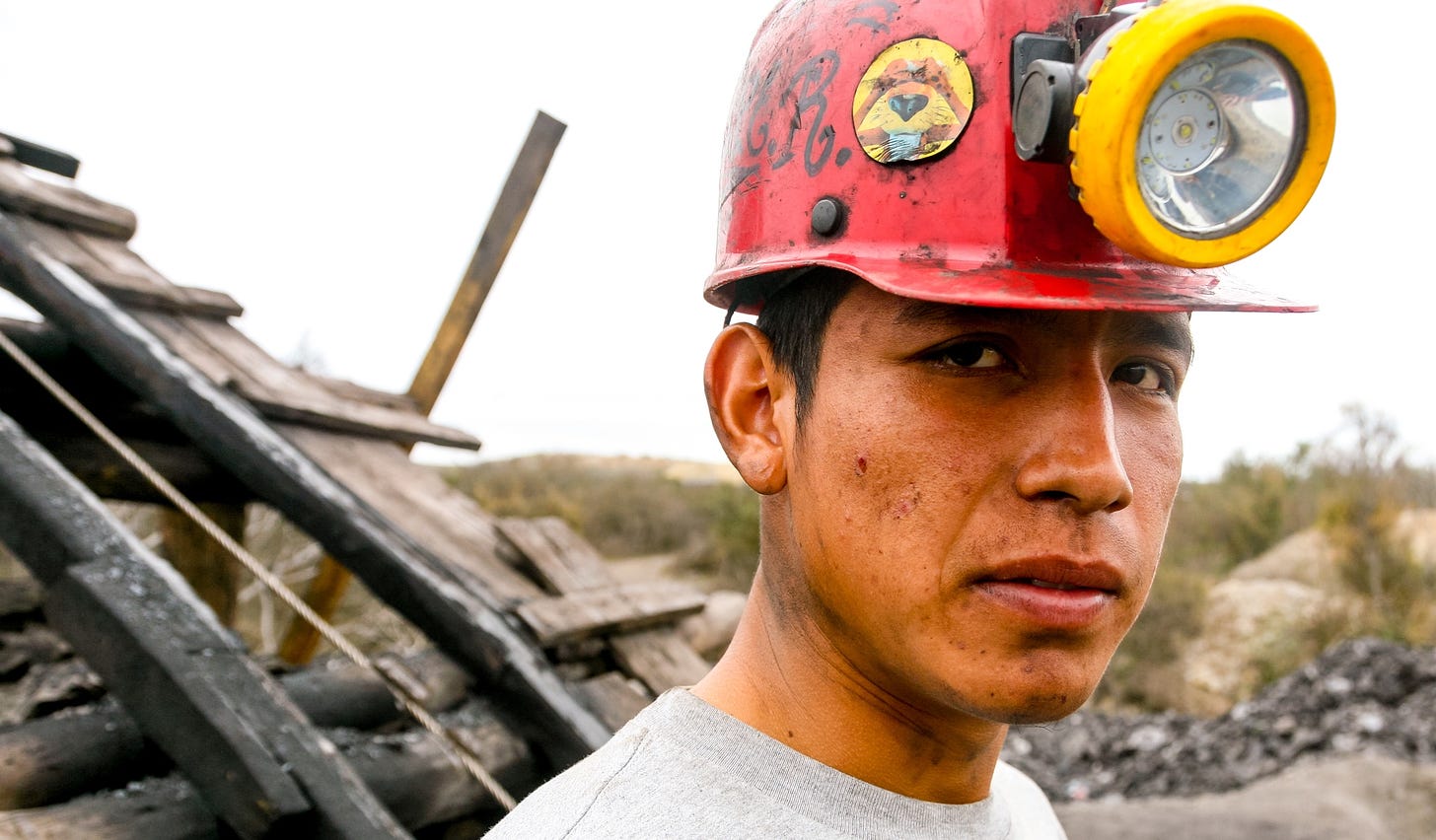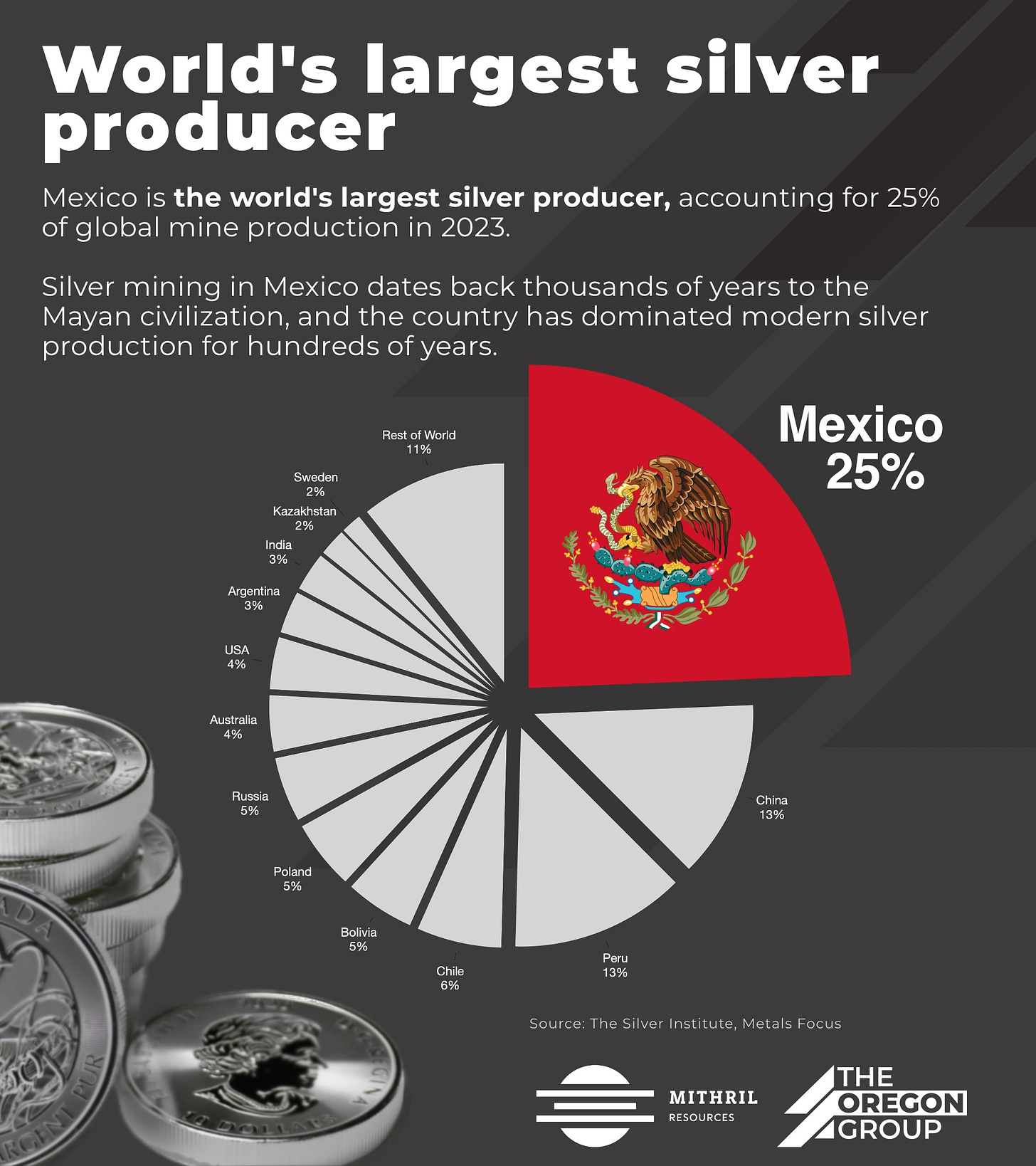Mining in Mexico, no more uncertainty
$2.5billion investment announced since election of new president
Sponsored spotlight: Mithril Silver and Gold Ltd is a precious metals exploration company developing one of the highest-grade silver jurisdictions in Mexico’s Sierra Madre Gold Silver Trend with multi-million ounce district potential for silver and gold.
Find out more: Mithril Silver and Gold Ltd
More than US$2.5billion investment has been announced in just two Mexico silver mining deals since the election of the new president Claudia Sheinbaum in June 2024:
Coeur Mining to buy Silvercrest in US$1.7 billion deal
First Majestic to buy with US$970m Gatos Silver
Mexico is the largest producer of silver in the world, accounting for 24% of global production — but political uncertainty has stalled investment; for example,
silver production in 2023 is down by 3.15% on 2022
mining investments decreased 5.8% in 2023 vs 2022
The uncertainty now seems to be over, and investment is responding.
🚀 Please smash the ♡ button, subscribe for the banter ✓ and share with friends and colleagues. We are always grateful for your comments and support.
Mexico's mining politics
President Andres Manuel Lopez Obrador
Mexico’s previous, popular president Andrés Manuel López Obrador (commonly referred to as AMLO) embraced anti-mining rhetoric and policies, including:
refusal to offer any new mining concessions since he took office in 2018
canceling lithium concession and a presidential decree threatening to nationalise lithium mining in February 2023
a proposal to ban open-pit mining (and fracking)
the Mining Reform shortening mining concession renewal terms, removing preferential terms, tighter permitting rules, and many other amendments
However, some of the reforms hit significant roadblocks, including Mexico’s Supreme Court granting an injunction against the mining law reform, declaring it unconstitutional — leading President Obrador to sign a judicial reform decree.
Needless to say, none of the above is exactly reassuring for mining investors with decades-long horizons and billions of dollars on the line.
The new president, Claudia Sheinbaum, from the same ruling Morena party as AMLO, won in June 2024 with a “supermajority” that may allow her to approve constitutional changes that eluded her predecessor (she was seated beside AMLO as he signed his judicial decree)
So why have some of the large mining majors decided now is the time to invest in Mexico?
President Claudia Sheinbaum
Contrary to initial concerns, the incoming Sheinbaum administration appears to be taking a more pragmatic approach to the mining sector.
This shift is evident in the appointment of key cabinet members, who will be significant in shaping the future of the government’s approach to the mining sector, and have been received well by the mining industry.
In particular, in the Ministry of Economy and Secretariat of Environment and Natural Resources (SEMARNAT), which have significant influence over foreign direct investment (FDI) and environmental permits:
Marcelo Ebrard as Economy Minister:
considered a moderate
announced attracting and supporting foreign investment as a “priority”
a former foreign minister
experience in international negotiations and trade
expected to lead renegotiation of the Treaty between Mexico, the US and Canada (T-MEC) in 2025
Alicia Bárcena as Environment and Natural Resources Minister:
previously Mexico's foreign minister, and is reportedly open to dialogue
advocate of sustainability and renewable energy
experience and knowledge across environmental and industrial issues
And it's not just the new cabinet that suggests the new president Claudia Sheinbaum is carving out her own policy path, away from AMLO's footsteps. For example,
the plan for a ban on open pit mining was not included in a list of 100 pledges outlined by President Sheinbaum on her inauguration, Oct 1, 2024
"I'm not sure that she's willing to fight that fight right now" — said José Sevilla-Macip, a senior research analyst at S&P Global Market Intelligence who focuses on economic and country risk in Latin America and the Caribbean
Instead, Sheinbaum highlighted how Mexico's lithium and copper sectors are priorities
“Something that strikes me is how it seems to be more of a ‘Sheinbaum cabinet’ and not an AMLO one. The technical capabilities of her team are there. Ebrard has shown to be an effective operator and his pragmatism should be well-received by investors”
— Rodolfo Ramos, a strategist at Bradesco BBI, told Bloomberg
The mining industry congratulated President Claudia Sheinbaum's inauguration, reaffirming its commitment to "open and constructive" dialogue and its dedication to protecting the environment.
The hope among many in the mining industry is that Sheinbaum’s technocratic background as a climate scientist and her calls to revolutionize Mexico’s energy policy — as well as a slowing economy — signals a pragmatic approach to industrial development, with the new administration expected to prioritize sustainable mining over shutting down project developments.
"The new administration should focus on establishing legal certainty and enhancing the sector's regulatory framework. Rather than imposing bans, they should enact regulations that align with responsible mining practices and global sustainability standards"
— stated Karen Flores, Director General, Camimex (Cámara Minera de México (Mexican Mining Chamber)
There remains significant anti-mining policies and sentiment.
For example, according to Sheinbaum's 100 pledges, her administration will not grant any new open-pit mining concessions — as the proposal to ban open-pit mining continues to advance in Mexico's Congress.
Camimex warns that 60% of the value of the national mining and metallurgical production in Mexico comes from open-pit operations, with more than 1 million formal jobs at risk and potentially leading to a 1% contraction of the national GDP.
For the mining industry, the transition from AMLO to Sheinbaum marks a shift from uncertainty to a more predictable landscape.
With a decisive election win, Mexico now has a president with a clear six-year mandate, offering a better understanding of the country’s political direction and a cabinet of ministers who bring a degree of familiarity.
New investment
This newfound stability since the election is already attracting investment to Mexico, including:
five Canada-based mining companies have announced plans to launch new projects in the country within the next six months.
Coeur Mining’s acquisition of Silvercrest in October, for US$1.7 billion
First Majestic’s acquisition of Gatos Silver in September, for US$970 million
mining investment in 2024 is expected to remain stable, compared to 2023, at approximately US$5 billion, according to Camimex. In July 2024, Mexico’s mining production value grew by 1.4%, driven primarily by the rising prices of silver, gold, copper, zinc, and other metals
according to the Instituto Nacional de Estadística, Geografía e Informática (INEGI), non-oil mining grew by 9.1% year-on-year in July, marking seven consecutive months of growth
The key with these investments is that they are not open-pit mines.
Strong mining foundations
Despite the recent political volatility, Mexico has a long history of mining, with established infrastructure and expertise, with new investment able to build on:
established mining culture, with a skilled workforce
legal framework, operating under English rule of law familiar for international investors
a federal government with states, such as Sonora, Chihuahua, and Zacatecas with a long history with mining, given significant autonomy in permitting and regulation (unike, for example, in Ecuador, with centralized decision-making)
trade agreements, including USMCA (previously NAFTA) which triggered its dispute resolution mechanism when AMLO attempted to nationalize the lithium industry; lending a layer of legal security
So, for example, the mining reforms, even under AMLO, were moderated, including:
payment to Indigenous communities living near mining operations was originally set at 10% of mining profits but lawmakers reduced it to 5%
the original reforms wanted to limit the length of mining concessions to 30 years (form 100 years), but lawmakers ultimately settled on 80 years
The opportunity of the energy transition
Mexico sits in one of the most strategic locations in the world: on the doorstep of the US, desperate to secure critical mineral supply — including silver, copper, lithium, etc — from China to power its own energy transition and data centres for its Artificial Intelligence revolution.
The opportunity is enormous.
Mexico is among the top 10 global producers of more than 15 metals and minerals:
world’s largest silver producer
2nd largest exporter of fluorspar, with world’s largest fluorspar mine
some of largest lithium reserves in the world
6th largest zinc producer
7th largest gold producer
10th largest copper producer
and many more, including bismuth, celestite, sodium sulphate, wollastonite, lead, molybdenum, diatomite, cadmium, graphite, baryte and manganese
In particular, the silver market’s deficit is forecast to grow by 17% in 2024, as demand for solar and tech soars, which would be the fourth consecutive year of deficit for the metal since 2021.
Security Concerns
As one miner told us of the drug cartels in Mexico: “If you look for trouble, you’ll find it.”
Otherwise, organized crime’s involvement in the mining industry is limited, with a focus on protecting trade routes and territory. And, importantly, the states where mining is most prevalent in Mexico have a strong history of intolerance to crime.
As per our newsletter headline, the cartels are, unfortunately, a certainty in Mexico but established miners are no strangers to the problem.
Conclusion
Investing in Mexico’s mining sector comes with both political and security risks.
However, the uncertainty that was so prevalent during the past six years of the AMLO administration has largely been addressed with the outcome of the election — allowing miners to start making long-term decisions.
We think the cycle has turned for Mexico.
🚀 Please smash the ♡ button, subscribe for the banter ✓ and share with friends and colleagues. We are always grateful for your comments and support.
Sponsored spotlight: Mithril Silver and Gold Ltd is a precious metals exploration company developing one of the highest-grade silver jurisdictions in Mexico’s Sierra Madre Gold Silver Trend with multi-million ounce district potential for silver and gold.
Mithril is currently progressing a fully funded drill program in the Copalquin District following its successful maiden JORC resource estimate delivered in November 2021 after only 15 months of drilling and with an all-in discovery cost of USD14.30 per ounce gold equivalent.*
Our Maiden JORC Mineral Resource — just the first target area of several in the district — the estimate summary:
2,416,000 tonnes @ 4.80 g/t gold, 141 g/t silver (6.81g/t AuEq*) for 373,000 oz gold plus 10,953,000 oz silver (Total 529,000 oz AuEq*) using a cut-off grade of 2.0 g/t AuEq*
28.6% of the resource tonnage is classified as indicated
*AuEq. = gold equivalent calculated using and gold:silver price ratio of 70:1. That is, 70 g/t silver = 1 g/t gold. The metal prices used to determine the 70:1 ratio are the cumulative average prices for 2021: gold USD1,798.34 and silver: USD25.32 (actual is 71:1) from kitco.com
Find out more: Mithril Silver and Gold Ltd
Find out more:










The mining industry in Mexico stands to gain significantly from its proximity to America's abundant and low-cost natural gas. This access will not only attract increased investment but also help alleviate inflationary pressures. As a result, Mexico could emerge as a vital mining vassal for the United States, reshaping the landscape of resource extraction in North America.